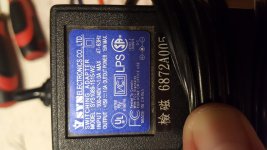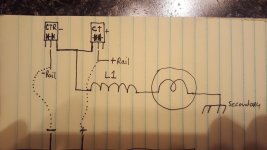The supply that I was referring to would have a ground, a positive 15v output and a negative 15v output. The actual output would likely be adjustable.
Did you have to replace any driver components in the output stage?
I don't remember, did it have output FETs that failed?
The reason that I'm asking is that I don't want you to power up with full rail voltage if there could be a problem.
Something like the following could work to help protect newly replaced outputs.
https://www.diyaudio.com/forums/car-audio/319174-4000-1-a-7.html#post5492949
Did you have to replace any driver components in the output stage?
I don't remember, did it have output FETs that failed?
The reason that I'm asking is that I don't want you to power up with full rail voltage if there could be a problem.
Something like the following could work to help protect newly replaced outputs.
https://www.diyaudio.com/forums/car-audio/319174-4000-1-a-7.html#post5492949
I don't have supply like that sorry.
It has new output drivers in it.
And the outputs were fine when I got amp no mosfets were bad it was just stuck in protect.
So are you suggesting that I make one off a Transformer in the amp and if so I'm not sure if I have everything needed to do so.
I've never done anything like that before and I'm just nervous I don't want to mess something up but I'll give it a shot if you can explain it to like what parts and wire type I should use.
It has new output drivers in it.
And the outputs were fine when I got amp no mosfets were bad it was just stuck in protect.
So are you suggesting that I make one off a Transformer in the amp and if so I'm not sure if I have everything needed to do so.
I've never done anything like that before and I'm just nervous I don't want to mess something up but I'll give it a shot if you can explain it to like what parts and wire type I should use.
All you need to make the low-voltage supply is a few windings on one of the transformers.
You can use external rectifiers like shown in the thread I posted or you can use the rectifiers that you pulled from the amp. I generally don't recommend using the rectifiers from the amp because some can be hard to find. I'm not sure what they're using in your amp.
The 1157 lamps are just for added protection.
You'll have to decide which way you want to do this.
Does your 12v power supply have an amp meter?
You can use external rectifiers like shown in the thread I posted or you can use the rectifiers that you pulled from the amp. I generally don't recommend using the rectifiers from the amp because some can be hard to find. I'm not sure what they're using in your amp.
The 1157 lamps are just for added protection.
You'll have to decide which way you want to do this.
Does your 12v power supply have an amp meter?
Can I take the 15v 1amp power supply I showed you in the picture and do the same thing with it by using the diodes and limiter? Just a thought
You need positive AND negative. The supply you posted is 15v only.
They also have a fuse that's very easy to blow and not readily replaceable.
They also have a fuse that's very easy to blow and not readily replaceable.
Ok so if I do wrap around one of the Transformers what type of wire do I need regular speaker wire or magnet wire and what gauge?
Can i use some of these diodes I have on hand?
1n5366b
1n5400b
1n4148
P6ke68a
Can i use some of these diodes I have on hand?
1n5366b
1n5400b
1n4148
P6ke68a
The low-speed diodes (standard-recovery) will work but will overheat if used for more than a short time.
Any insulated wire 22g or larger will work.
Do you have any rectifiers that you can pull from a junk amp you have laying around?
Any insulated wire 22g or larger will work.
Do you have any rectifiers that you can pull from a junk amp you have laying around?
The CT is the positive. The CTR is the negative. Output to the rail caps is on the center leg.
You'll need rail caps in the amp. They don't have to be the originals. Whatever is easy.
Power up then quickly off to check polarity if you're unsure if you have it right.
You'll need rail caps in the amp. They don't have to be the originals. Whatever is easy.
Power up then quickly off to check polarity if you're unsure if you have it right.
Im confused do i put the rectifiers in the amp?
One side of my winding will go to the center tap ground where do I put the other side on the rectifiers?
One side of my winding will go to the center tap ground where do I put the other side on the rectifiers?
The other end of the winding will go to either outer leg of each of the rectifiers.
The output leg of the rectifiers will go to the terminals of the rail caps that are not connected to the secondary ground.
It's better to solder to the caps than to risk damaging the pads for the original rectifiers.
The output leg of the rectifiers will go to the terminals of the rail caps that are not connected to the secondary ground.
It's better to solder to the caps than to risk damaging the pads for the original rectifiers.
Yes. All rail caps have one terminal connected to the secondary ground. The rectifiers connect to the terminal that is not connected to the secondary ground.
Ok they're is silicone in the Transformers for reinforcement so I'm going to cut some out enough to where I can do my windings and I'll get back with you tomorrow as soon as I get off work.
Thanks for all the help perry.
Thanks for all the help perry.
I didn't see the photo of the circuit. The lamp is better in series with one of the rectifiers instead of ground because if there is a problem, it's likely to cause the current to flow between the outputs and not to ground.
When opening a space, do so with something that cannot damage the windings. A bamboo skewer of a piece of plastic is better than a razor knife. You can even use a piece of fishing line to cut if you can get a strand through.
When opening a space, do so with something that cannot damage the windings. A bamboo skewer of a piece of plastic is better than a razor knife. You can even use a piece of fishing line to cut if you can get a strand through.
- Status
- Not open for further replies.
- Home
- General Interest
- Car Audio
- Audiopipe AP1500D issue

